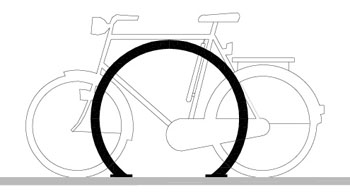
Bicycle Parking Requirements
Project Status: Completed in 2013
The new bicycle parking requirements in San Francisco became effective on September 9, 2013. The new bicycle parking law sets San Francisco as a national model for bicycle parking requirements resulting from a one-year collaborative effort between different City departments, bicycle advocacy groups, property owners, and development community.

Bike ridership in San Francisco has significantly increased over the past decade reflected in both national American Community Survey commute ridership counts and local SFMTA bicycle counts.
Bicycle parking requirements were first adopted into San Francisco's Planning Code in 1996. At that time, the requirement only applied to City-owned and leased buildings. These requirements were subsequently expanded on a piecemeal basis to City-owned and privately-owned parking garages in 1998. In 2001 new commercial and industrial developments were required to provide bicycle parking. More recently, in 2005, residential developments were required to provide bicycle parking. Compared to best practices, national standards, as well as the trends in rate of bicycling as a mode of commute, the City found these requirements inefficient in responding to the growing need for bicycle infrastructure.
- Zoning Administrator Bulletin No. 9
- Bicycle Parking Sign design templates (requires Adobe Illustrator to edit/modify files) - see above Bulletin No.9 for design guidelines:
- Ordinance No. 0183-13
- Presentation to the Land Use Committee of the Board of Supervisors
- General Plan and Planning Code Amendment - Executive Summary
- Exhibit A: Excerpt from SFMTA's Bicycling Strategy on benefits of bicycling
- Exhibit B: Bicycle Parking in Cities Similar to San Francisco
- Exhibit C: Draft Zoning Administrator Bulletin
- Exhibit D: CalGreen State Requirements for Bicycle Parking
- Exhibit E: Draft Planning Commission Resolution
- Exhibit F: Draft Ordinance for General Plan Amendments
- Exhibit G: Draft Ordinance for Planning Code Amendments
- Exhibit H: Draft Resolution for Planning Code Amendments
On August 9, 2012, the Planning Department proactively brought a comprehensive overhaul of bicycle parking requirement in the Planning Code to the Planning Commission in response to the surge in ridership and need for bicycle parking.
The new law regulates long-term and short-term bicycle parking based upon the anticipated need for different uses. A residential or office building would require more long-term bicycle parking spaces for residents and employees, respectively, while a retail store would require more short-term bicycle parking to accommodate shoppers. The new law upgrades the quantity of bicycle parking spaces required for each use types based on comparisons with similar cities with high bike ridership- such as Vancouver, Portland, and New York- as well as national standards from Association of Pedestrian and Bicycle Professionals.
The new bicycle parking requirements in San Francisco sit atop similar standards in the nation including outstanding features:
- Identifies separate requirements for two types of bicycle parking: long-term parking for residents and employees (Class One), and short-term parking for visitors (Class Two);
- Defines requirements for multiple use categories based on anticipated generated bike trips for each use;
- Increases bicycle parking requirements for all uses, based on other similar urban cities: Vancouver, Portland, New York, and National Standards;
- Prioritizes easy and direct access to bicycle parking facilities through location and placement requirements;
- Allows conversion of required car parking to bicycle parking;
- Establishes design, layout, and clearance standards through user-friendly graphics in a Zoning Administrator Bulletin;
- Prohibits obtaining a variance for quantity of bicycle parking;
- Requires compliance with new standards for all new construction as well as certain renovations such as addition of a dwelling unit, enlargement by 20%, change of use when bicycle parking requirement would increase by 15%, or addition of vehicle parking.
- Establishes new, increased requirements for the provision of showers and lockers based upon use type and occupied floor area;
- Allows payment of in-lieu fee to satisfy portions of Class two bicycle parking requirements;
- Establishes a bicycle parking fund administered by SFMTA for the provision of short-term bicycle parking;
- Requires existing City-owned buildings and garages to generally conform with the new requirements within a one year period.
